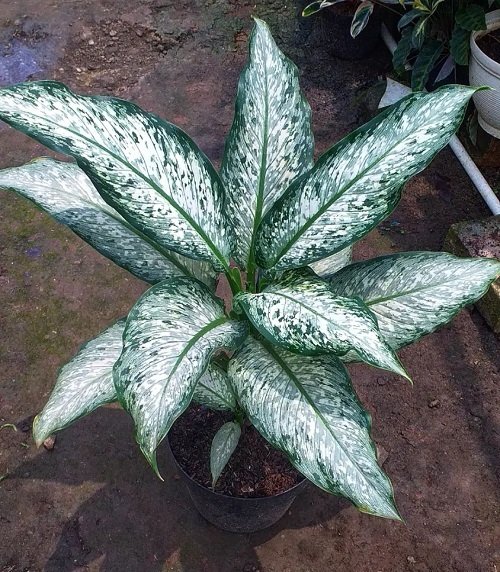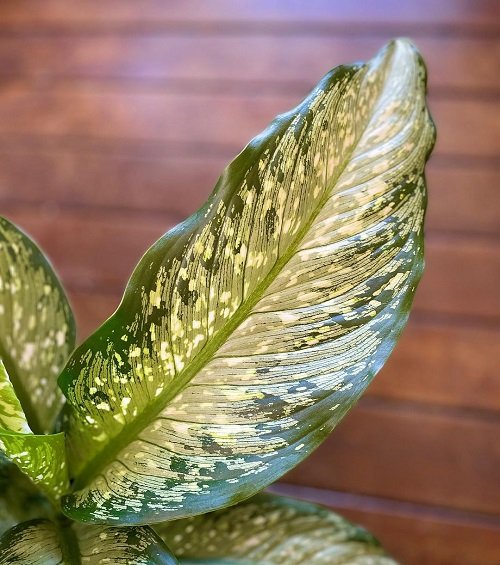Read about Dieffenbachia Memoria Corsii Care Guide with expert tips and insights for thriving foliage and vibrant growth.

Whether you’re a beginner or an experienced plant enthusiast, the Dieffenbachia Memoria Corsii is a fantastic houseplant to have in your collection! Here are all the details.
Read about the Dieffenbachia Cheetah Plant Care and Growing Information here
Dieffenbachia Memoria Corsii Plant Information

Dieffenbachia Memoria Corsii is a popular cultivar of the Dieffenbachia genus, known for its striking foliage and vibrant variegation. It is a tropical plant native to the rainforests of Central and South America.
The origin of its name, “Memoria Corsii,” pays homage to an Italian botanist named Corsi. This Dieffenbachia cultivar features large, lance-shaped leaves with prominent veins and a stunning combination of dark green and creamy white variegation. The variegation patterns can vary, with some leaves displaying more white than green and vice versa.
Dieffenbachia Memoria Corsii is valued for its aesthetic appeal, adding a touch of tropical beauty to indoor spaces. However, it’s important to note that all parts of the plant are toxic if ingested, so caution should be exercised around children and pets. With proper care, including bright, indirect light, regular watering, and occasional fertilization, it can thrive and bring beauty to any home or office environment.
Learn How to Care for Dieffenbachia Indoors here
Propagating Dieffenbachia Memoria Corsii

Dieffenbachia Memoria Corsii can be propagated through stem cuttings or by dividing the plant.
Stem Cuttings:
- Select a healthy stem from Dieffenbachia Memoria Corsii that has multiple nodes. Nodes are the points on the stem where leaves emerge.
- Using clean, sharp pruning shears, cut a 4-6 inch section of the stem just below a node. Remove any leaves from the lower portion of the cutting.
- Allow the cut end to dry and callus over for a few hours to reduce the risk of rotting.
- Prepare a well-draining potting mix, such as a blend of peat moss and perlite or vermiculite.
- Plant the cutting in the potting mix, burying the lower portion of the stem in the soil. Ensure that at least one node is below the soil surface.
- Place the pot in a warm and humid location with bright, indirect light. Covering the pot with a clear plastic bag or using a propagator can help create a humid environment.
- Mist the cutting regularly to maintain humidity and keep the soil slightly moist but not waterlogged.
- After a few weeks, new growth should emerge, indicating that the cutting has successfully rooted. At this point, you can gradually acclimate the new plant to normal indoor conditions.
Find How to Grow Dieffenbachia from Cuttings here
Division:
- When the parent Dieffenbachia Memoria Corsii has grown large enough, it can be divided into multiple plants.
- Carefully remove the plant from its pot and gently separate the root ball into two or more sections. Make sure each division has its own roots and stems.
- Plant each division in a separate pot with a well-draining potting mix.
- Provide the newly divided plants with the same care as mature Dieffenbachia Memoria Corsii, including bright, indirect light, regular watering, and suitable humidity.
Requirements for Growing Dieffenbachia Memoria Corsii
Location
Dieffenbachia Memoria Corsii flourishes in bright, indirect light. It is important to avoid direct sunlight as it can lead to leaf scorching.
Place the plant in an area that receives filtered or indirect light, and remember to rotate it regularly to promote even growth.
Soil
For optimal growth of Dieffenbachia Memoria Corsii, it is crucial to use well-draining and aerated soil to prevent waterlogging and root rot. A recommended soil mix includes the following proportions:
1 part peat moss: Retains moisture effectively while ensuring proper root aeration.
1 part perlite: Enhances drainage and creates air pockets within the soil.
1 part sand: Adds weight to the soil and aids in drainage.
Check out a Weird Soil Test here
This combination creates an ideal soil environment for Dieffenbachias, with a rich organic matter content and a slightly acidic to neutral pH.
Water
To maintain optimal moisture levels, this plant prefers consistently moist soil without being waterlogged. Water once a week or when the top inch of soil feels dry.
Ensure proper drainage to prevent root rot. The plant will indicate its water needs by slightly drooping leaves, so allowing it to dry out between waterings is suitable.
Here is How to Treat Root Rot in Houseplants Like a Pro
Temperature
Dieffenbachia Memoria Corsii thrives in warm temperatures and are susceptible to cold drafts. The optimal temperature range for them is between 65°F and 75°F (18°C to 24°C). They are not tolerant of temperatures below 60°F (16°C).
To prevent temperature fluctuations and minimize stress on the plant, it is important to avoid placing it near cold windows or air conditioning vents. By ensuring a stable and suitable temperature environment, the plant can flourish.
Humidity
Dieffenbachia Memoria Corsii typically thrives in higher humidity levels. The ideal range for humidity is between 40% and 60%.
Regularly mist the plant’s leaves and its surrounding area using a spray bottle filled with water. Aim to mist once or twice a day, especially during the drier winter months.
Here are 10 Ways To Increase Humidity For Houseplants That Work
Utilize a room humidifier to increase the moisture in the air surrounding the plant. This can be particularly beneficial during the winter when the air tends to be drier.
By implementing these practices, you can create a more favorable humidity environment for Dieffenbachia Memoria Corsii’s well-being and growth.
Dieffenbachia Memoria Corsii Care
Fertilizer
Fertilize Dieffenbachia Memoria Corsii from spring through summer, which is their active growing period. Use a balanced, water-soluble fertilizer formulated specifically for houseplants like 10-10-10 or similar.
Dilute the fertilizer to half or a quarter strength of the recommended dosage on the fertilizer packaging. Overfertilizing can lead to salt build-up and cause damage to the plant. Apply the diluted fertilizer every 4-6 weeks during the active growing season.
Here are the Top Overfertilization Symptoms in Indoor Plants and Solutions
Avoid getting fertilizer on the leaves, as this can cause leaf burn. Always follow the instructions on the fertilizer packaging for proper application.
Pests and Diseases
Dieffenbachia Memoria Corsii is generally quite resilient but can still be susceptible to spider mite infestation. These tiny pests can cause stippling, yellowing leaves, and the presence of fine webbing.
Mealybugs can also be a problem, clustering on the leaves, stems, and leaf axils. They can lead to stunted growth and yellowing leaves. Scale insects may appear as raised bumps on the foliage and can cause leaf yellowing and a sticky residue.
In terms of diseases, root rot can occur if the soil is consistently waterlogged, leading to mushy roots and wilting foliage. Leaf spot diseases, often caused by fungal pathogens, can result in the appearance of spots or lesions on the leaves.
Check out types of Common Pests in Your Garden & How to Get Rid of Them here
To prevent and manage these issues, regular inspection is crucial. Promptly address any infestations by manually removing pests or using insecticidal soap or neem oil.
Ensure proper watering practices, allowing the soil to partially dry out between waterings to prevent root rot. Maintain good air circulation and avoid overwatering to minimize the risk of leaf spot diseases.



